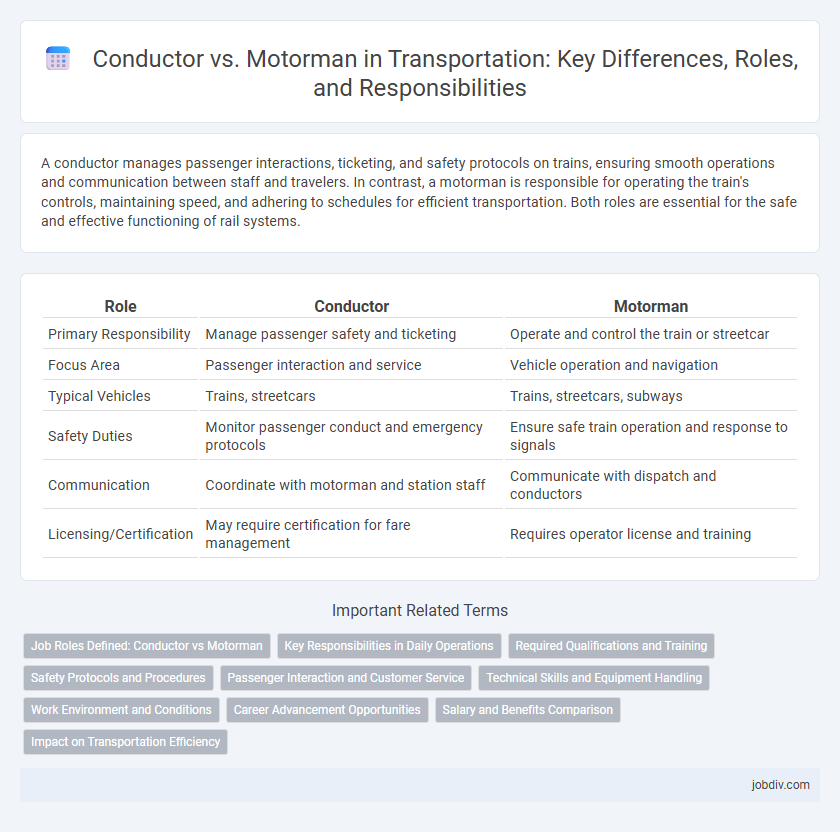A conductor manages passenger interactions, ticketing, and safety protocols on trains, ensuring smooth operations and communication between staff and travelers. In contrast, a motorman is responsible for operating the train's controls, maintaining speed, and adhering to schedules for efficient transportation. Both roles are essential for the safe and effective functioning of rail systems.
Table of Comparison
| Role | Conductor | Motorman |
|---|---|---|
| Primary Responsibility | Manage passenger safety and ticketing | Operate and control the train or streetcar |
| Focus Area | Passenger interaction and service | Vehicle operation and navigation |
| Typical Vehicles | Trains, streetcars | Trains, streetcars, subways |
| Safety Duties | Monitor passenger conduct and emergency protocols | Ensure safe train operation and response to signals |
| Communication | Coordinate with motorman and station staff | Communicate with dispatch and conductors |
| Licensing/Certification | May require certification for fare management | Requires operator license and training |
Job Roles Defined: Conductor vs Motorman
The conductor is primarily responsible for managing passenger safety, fare collection, and overseeing the boarding process on trains, while the motorman operates the train's controls, ensuring safe and efficient movement along the tracks. Conductors communicate with dispatchers and coordinate train schedules, whereas motormen focus on controlling speed, braking, and adherence to signals. Both roles are crucial for safe railway operations, with conductors handling customer service and operational coordination, and motormen concentrating on train navigation and mechanical control.
Key Responsibilities in Daily Operations
Conductors manage passenger safety, ticketing, and coordinate communication between the train crew during daily operations. Motormen are responsible for operating the train's controls, ensuring smooth acceleration, braking, and adherence to schedules. Both roles collaborate to maintain efficient and safe transit services.
Required Qualifications and Training
Conductors must complete formal training programs covering safety protocols, signaling, and passenger management, often requiring certification from transit authorities. Motormen need extensive education in vehicle operation, including simulator training and hands-on experience with control systems, alongside knowledge of emergency procedures. Both roles demand physical fitness and strong situational awareness to ensure safe and efficient public transportation services.
Safety Protocols and Procedures
Conductors follow strict safety protocols including passenger communication, emergency response coordination, and compliance with railway regulations to ensure onboard safety. Motormen operate train controls with rigorous adherence to operational procedures, vigilance in track conditions, and precise train handling to prevent accidents. Both roles require continuous training in emergency evacuation drills and safety equipment usage to maintain passenger and crew protection.
Passenger Interaction and Customer Service
Conductors maintain direct passenger interaction by assisting with ticketing, providing travel information, and ensuring safety while onboard, enhancing overall customer service. Motormen focus primarily on operating the train or tram, with limited direct engagement with passengers, concentrating on vehicle control and schedule adherence. Effective coordination between conductors and motormen ensures smooth transit operations and a positive passenger experience.
Technical Skills and Equipment Handling
Conductors specialize in managing train operations, passenger safety, and coordinating communication systems, requiring expertise in signal interpretation and emergency procedures. Motormen focus on operating the train's controls, such as throttle, brakes, and speed regulation, demanding precise knowledge of locomotive mechanics and real-time equipment monitoring. Proficiency in equipment handling for conductors includes managing coupling devices and communication tools, while motormen must excel in controlling traction motors and automated safety systems.
Work Environment and Conditions
Conductors primarily work on trains or streetcars, managing passenger safety and ticketing in a dynamic environment exposed to variable weather conditions and frequent station stops. Motormen operate the vehicle controls in the operator's cab, requiring constant attention to track signals and speed, often in confined spaces with limited exposure to passengers. Both roles involve shift work and adherence to strict safety protocols, but conductors face more direct passenger interaction while motormen focus on vehicle operation and navigation.
Career Advancement Opportunities
Conductors in transportation typically have broader career advancement opportunities, often progressing to supervisory or management roles due to their responsibility for passenger safety, ticketing, and communication. Motormen, primarily responsible for operating trains, may advance into roles such as train engineers or train operators with increased technical expertise. Both positions offer upward mobility, but conductors generally have a wider range of pathways in operations management and customer service leadership.
Salary and Benefits Comparison
Conductors typically earn an average salary ranging from $50,000 to $65,000 annually, while motormen often receive slightly higher pay between $55,000 and $70,000 due to specialized operating skills. Benefits for both roles usually include health insurance, retirement plans, and paid time off, but motormen may access additional incentives like overtime premiums and skill-based bonuses. Salary growth and job stability depend heavily on the employer, region, and union agreements in the transportation sector.
Impact on Transportation Efficiency
The conductor plays a crucial role in managing passenger safety, ticketing, and communication, directly influencing the smooth flow of operations and reducing delays on rail systems. The motorman controls train speed and adherence to schedules, which impacts overall transit time and energy efficiency. Coordinated efforts between conductors and motormen enhance punctuality and operational reliability, leading to improved transportation efficiency.
Conductor vs Motorman Infographic

 jobdiv.com
jobdiv.com